DN12: Decontamination Methods & Immunizations in Dentistry
VerifiedAdded on 2023/06/14
|16
|4316
|388
Practical Assignment
AI Summary
This assignment solution comprehensively addresses cross-infection control within dental environments. It begins by explaining various methods to prevent cross-infection, linking them to standard infection control policies and procedures, including hand hygiene, PPE, and equipment sterilization. A reflective piece explores the learner's experience in preparing a clinical area to control cross-infection, using models like Gibbs or Johns. The solution details the causes of cross-infection and routes of microorganism transmission, such as direct contact, airborne droplets, and inoculation injuries. It includes a table defining terms like pathogens, non-pathogens, viruses, fungi, and spores, with examples and transmission methods. Furthermore, it explains standard precautions and practice policies related to cross-infection, the necessity of immunizations for dental personnel, and the time scale for immunizations before starting clinical work. The assignment also describes infectious conditions affecting different age groups in dental settings, like Hepatitis, Tuberculosis, HIV/AIDS, and Herpes simplex type 1, including transmission routes, immunizations, and precautions. Finally, it identifies and evaluates decontaminants used in surgery, specifying their effectiveness against various microorganisms. This resource is available on Desklib, a platform offering AI-based study tools and a wealth of solved assignments for students.
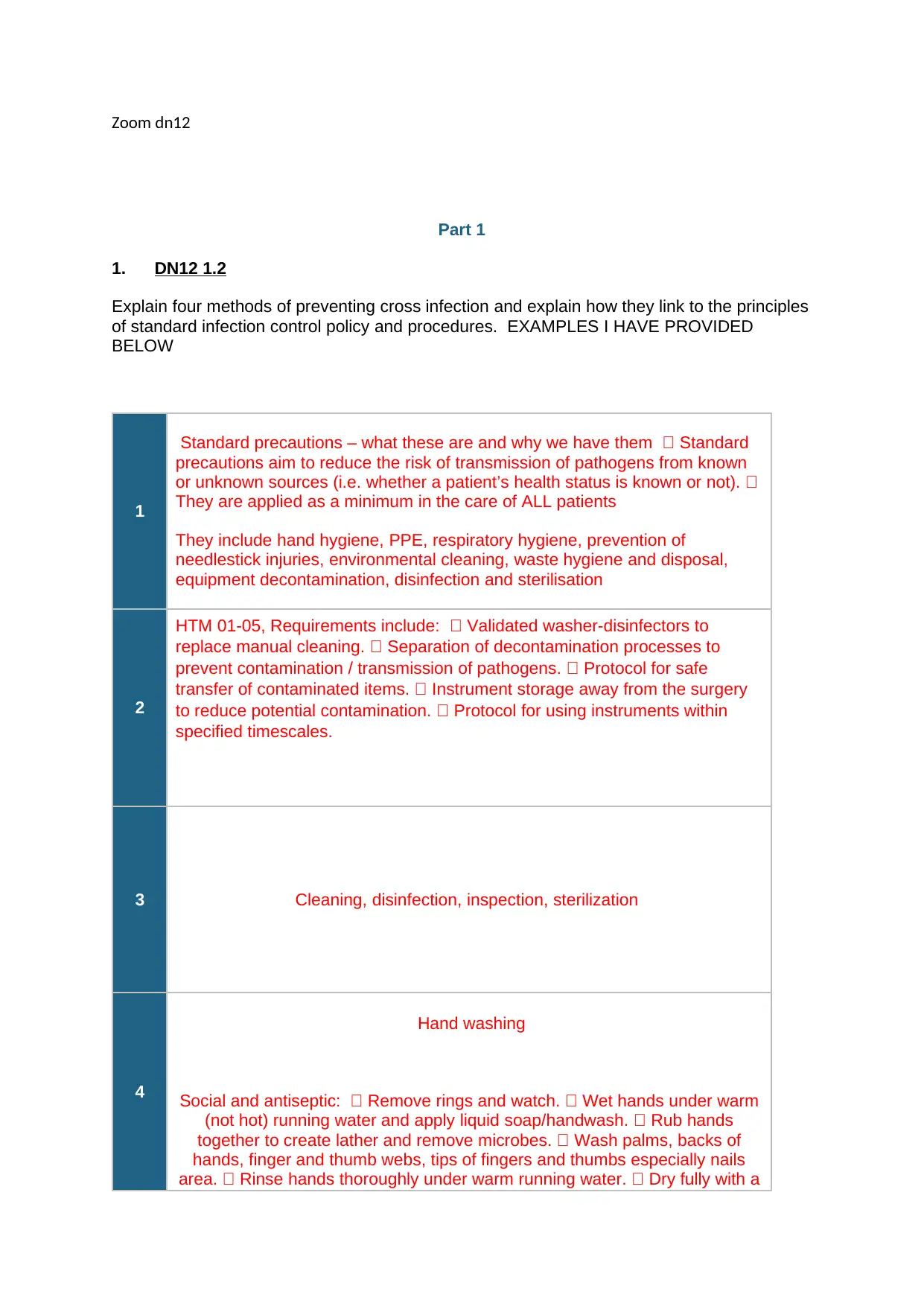
Zoom dn12
Part 1
1. DN12 1.2
Explain four methods of preventing cross infection and explain how they link to the principles
of standard infection control policy and procedures. EXAMPLES I HAVE PROVIDED
BELOW
1
Standard precautions – what these are and why we have them Standard
precautions aim to reduce the risk of transmission of pathogens from known
or unknown sources (i.e. whether a patient’s health status is known or not).
They are applied as a minimum in the care of ALL patients
They include hand hygiene, PPE, respiratory hygiene, prevention of
needlestick injuries, environmental cleaning, waste hygiene and disposal,
equipment decontamination, disinfection and sterilisation
2
HTM 01-05, Requirements include: Validated washer-disinfectors to
replace manual cleaning. Separation of decontamination processes to
prevent contamination / transmission of pathogens. Protocol for safe
transfer of contaminated items. Instrument storage away from the surgery
to reduce potential contamination. Protocol for using instruments within
specified timescales.
3 Cleaning, disinfection, inspection, sterilization
4
Hand washing
Social and antiseptic: Remove rings and watch. Wet hands under warm
(not hot) running water and apply liquid soap/handwash. Rub hands
together to create lather and remove microbes. Wash palms, backs of
hands, finger and thumb webs, tips of fingers and thumbs especially nails
area. Rinse hands thoroughly under warm running water. Dry fully with a
Part 1
1. DN12 1.2
Explain four methods of preventing cross infection and explain how they link to the principles
of standard infection control policy and procedures. EXAMPLES I HAVE PROVIDED
BELOW
1
Standard precautions – what these are and why we have them Standard
precautions aim to reduce the risk of transmission of pathogens from known
or unknown sources (i.e. whether a patient’s health status is known or not).
They are applied as a minimum in the care of ALL patients
They include hand hygiene, PPE, respiratory hygiene, prevention of
needlestick injuries, environmental cleaning, waste hygiene and disposal,
equipment decontamination, disinfection and sterilisation
2
HTM 01-05, Requirements include: Validated washer-disinfectors to
replace manual cleaning. Separation of decontamination processes to
prevent contamination / transmission of pathogens. Protocol for safe
transfer of contaminated items. Instrument storage away from the surgery
to reduce potential contamination. Protocol for using instruments within
specified timescales.
3 Cleaning, disinfection, inspection, sterilization
4
Hand washing
Social and antiseptic: Remove rings and watch. Wet hands under warm
(not hot) running water and apply liquid soap/handwash. Rub hands
together to create lather and remove microbes. Wash palms, backs of
hands, finger and thumb webs, tips of fingers and thumbs especially nails
area. Rinse hands thoroughly under warm running water. Dry fully with a
Paraphrase This Document
Need a fresh take? Get an instant paraphrase of this document with our AI Paraphraser

disposable paper towel. Use towel to turn off tap.
Surgical: Remove rings and watch. Using an antimicrobial disinfectant
hand wash, vigorously clean nails, hands and forearms for 2 minutes to
remove microbes. Rinse thoroughly for several minutes. Hold hands
higher than the elbows to prevent run off of water. Dry with a sterile towel
preventing the towel from touching the area above the elbows. Adopt a no-
touch technique prior to and after donning gloves.
2. DN12 1.5
Write a reflection on how to prepare your clinical area to control cross infection.
The learner must write a reflection based on a model such as Gibbs or Johns on how they
set up their surgery and ensure that cross infection is controlled throughout the session. Do
they feel their procedures work or should they be doing anything differently? To be awarded
maximum marks for content, the reflection should concentrate on the learner’s own practice.
Descriptio
n
The cross infection disease is required to controlled by all the people
to do not get harmed from the infectious diseases. I had learned that to
stop and control the spread of infection is important to be implemented
by an individual person. throughout the session there are so many
things that I had learned and get to know such as importance of
controlling the spreading of disease, its measures and precaution and
such more.
Feelings
During the session, I was feeling nervous and concepts before the
starting of the session as I did not known much about the cross
infection process and its importance but later on, my tutor and seniors
help me to tell and guide me about the entire process of the topic.
Evaluation
During the session, at first I was not able to understand the things and
concepts clearly where I got demotivated and felt good but after that
my tutor helps me and guided me with giving different examples and
using the technology as projector to describe the subject accurately
which was went actually well at that time and can be able to
understand the subject.
Analysis I analysed that attending this session helps me to understand about
the cross infectious diseases where I had learned many things like the
infectious disease can be spread directly and indirectly accordingly. I
Surgical: Remove rings and watch. Using an antimicrobial disinfectant
hand wash, vigorously clean nails, hands and forearms for 2 minutes to
remove microbes. Rinse thoroughly for several minutes. Hold hands
higher than the elbows to prevent run off of water. Dry with a sterile towel
preventing the towel from touching the area above the elbows. Adopt a no-
touch technique prior to and after donning gloves.
2. DN12 1.5
Write a reflection on how to prepare your clinical area to control cross infection.
The learner must write a reflection based on a model such as Gibbs or Johns on how they
set up their surgery and ensure that cross infection is controlled throughout the session. Do
they feel their procedures work or should they be doing anything differently? To be awarded
maximum marks for content, the reflection should concentrate on the learner’s own practice.
Descriptio
n
The cross infection disease is required to controlled by all the people
to do not get harmed from the infectious diseases. I had learned that to
stop and control the spread of infection is important to be implemented
by an individual person. throughout the session there are so many
things that I had learned and get to know such as importance of
controlling the spreading of disease, its measures and precaution and
such more.
Feelings
During the session, I was feeling nervous and concepts before the
starting of the session as I did not known much about the cross
infection process and its importance but later on, my tutor and seniors
help me to tell and guide me about the entire process of the topic.
Evaluation
During the session, at first I was not able to understand the things and
concepts clearly where I got demotivated and felt good but after that
my tutor helps me and guided me with giving different examples and
using the technology as projector to describe the subject accurately
which was went actually well at that time and can be able to
understand the subject.
Analysis I analysed that attending this session helps me to understand about
the cross infectious diseases where I had learned many things like the
infectious disease can be spread directly and indirectly accordingly. I

also came to know about the different equipment’s and safety measure
which can be utilized at the dental work place which can create a good
nd clean environment.
Conclusion
In the conclusion, I was able to understand the entire process and
things related to the cross infectious disease while the surgery and
able to know the measures of cleanliness.
Action plan
From the session, I learned many things but requires to enhance my
research skill so that I can able to search and get the valid information
about this topic in brief manner.
Part 2
1. DN12 2.1
Describe the causes of cross infection and explain the routes of transmission for
microorganisms.
Causes Infection occurs when pathogenic micro-organisms gain entry to the
body tissues. Entry can occur via the skin, eyes, mouth.
Routes
Direct contact – with body fluids, blood, saliva or vomit. Airborne
droplets – of blood or saliva – from sneezing or coughing. Aerosol
spray – containing blood or saliva – created during the use of dental
handpieces and water sprays. Direct entry – through damaged skin
or membranes – cuts, grazes, piercing the eye membrane.
which can be utilized at the dental work place which can create a good
nd clean environment.
Conclusion
In the conclusion, I was able to understand the entire process and
things related to the cross infectious disease while the surgery and
able to know the measures of cleanliness.
Action plan
From the session, I learned many things but requires to enhance my
research skill so that I can able to search and get the valid information
about this topic in brief manner.
Part 2
1. DN12 2.1
Describe the causes of cross infection and explain the routes of transmission for
microorganisms.
Causes Infection occurs when pathogenic micro-organisms gain entry to the
body tissues. Entry can occur via the skin, eyes, mouth.
Routes
Direct contact – with body fluids, blood, saliva or vomit. Airborne
droplets – of blood or saliva – from sneezing or coughing. Aerosol
spray – containing blood or saliva – created during the use of dental
handpieces and water sprays. Direct entry – through damaged skin
or membranes – cuts, grazes, piercing the eye membrane.
⊘ This is a preview!⊘
Do you want full access?
Subscribe today to unlock all pages.

Trusted by 1+ million students worldwide

Inoculation injury – with contaminated instrument – such as needle
stick injury
2. DN12 2.2, 2.3, 2.4 range 1a-d
Complete the table below, explaining what each term stands for, whether they are
infectious/non-infectious and give an example of each and how they are transmitted.
Term Infectious/Non-
Infectious Explain what they are Example
Pathogen Infectious Micro-organisms that are capable
of causing disease
Streptococci
Candida albicans
Herpes
simplex
Non-
pathogen Non Infectious Non-pathogen is incapable to
cause disease. E.coli bacteria
Bacteria Infectious It transmitted when a bacteria
increases its number in the body
and causes reaction.
Salmonella
Virus Infectious
It converts the genetic material
into the cells and harms the
internal body of human.
Corona Virus
Fungi Non infectious Fungi enters the tissue in the
body and misguide the functions Candida Auris
stick injury
2. DN12 2.2, 2.3, 2.4 range 1a-d
Complete the table below, explaining what each term stands for, whether they are
infectious/non-infectious and give an example of each and how they are transmitted.
Term Infectious/Non-
Infectious Explain what they are Example
Pathogen Infectious Micro-organisms that are capable
of causing disease
Streptococci
Candida albicans
Herpes
simplex
Non-
pathogen Non Infectious Non-pathogen is incapable to
cause disease. E.coli bacteria
Bacteria Infectious It transmitted when a bacteria
increases its number in the body
and causes reaction.
Salmonella
Virus Infectious
It converts the genetic material
into the cells and harms the
internal body of human.
Corona Virus
Fungi Non infectious Fungi enters the tissue in the
body and misguide the functions Candida Auris
Paraphrase This Document
Need a fresh take? Get an instant paraphrase of this document with our AI Paraphraser
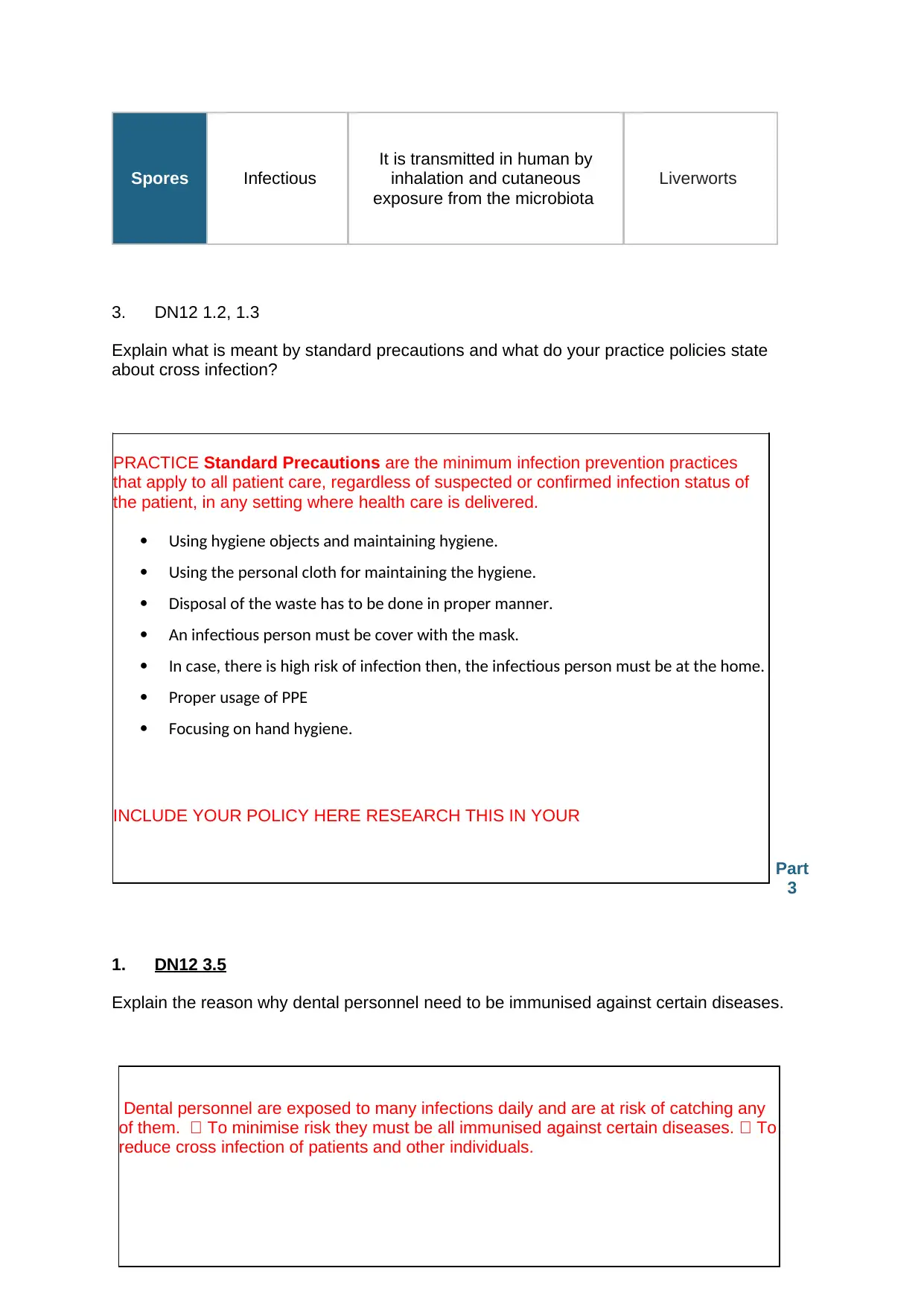
Spores Infectious
It is transmitted in human by
inhalation and cutaneous
exposure from the microbiota
Liverworts
3. DN12 1.2, 1.3
Explain what is meant by standard precautions and what do your practice policies state
about cross infection?
Part
3
1. DN12 3.5
Explain the reason why dental personnel need to be immunised against certain diseases.
PRACTICE Standard Precautions are the minimum infection prevention practices
that apply to all patient care, regardless of suspected or confirmed infection status of
the patient, in any setting where health care is delivered.
Using hygiene objects and maintaining hygiene.
Using the personal cloth for maintaining the hygiene.
Disposal of the waste has to be done in proper manner.
An infectious person must be cover with the mask.
In case, there is high risk of infection then, the infectious person must be at the home.
Proper usage of PPE
Focusing on hand hygiene.
INCLUDE YOUR POLICY HERE RESEARCH THIS IN YOUR
Dental personnel are exposed to many infections daily and are at risk of catching any
of them. To minimise risk they must be all immunised against certain diseases. To
reduce cross infection of patients and other individuals.
It is transmitted in human by
inhalation and cutaneous
exposure from the microbiota
Liverworts
3. DN12 1.2, 1.3
Explain what is meant by standard precautions and what do your practice policies state
about cross infection?
Part
3
1. DN12 3.5
Explain the reason why dental personnel need to be immunised against certain diseases.
PRACTICE Standard Precautions are the minimum infection prevention practices
that apply to all patient care, regardless of suspected or confirmed infection status of
the patient, in any setting where health care is delivered.
Using hygiene objects and maintaining hygiene.
Using the personal cloth for maintaining the hygiene.
Disposal of the waste has to be done in proper manner.
An infectious person must be cover with the mask.
In case, there is high risk of infection then, the infectious person must be at the home.
Proper usage of PPE
Focusing on hand hygiene.
INCLUDE YOUR POLICY HERE RESEARCH THIS IN YOUR
Dental personnel are exposed to many infections daily and are at risk of catching any
of them. To minimise risk they must be all immunised against certain diseases. To
reduce cross infection of patients and other individuals.
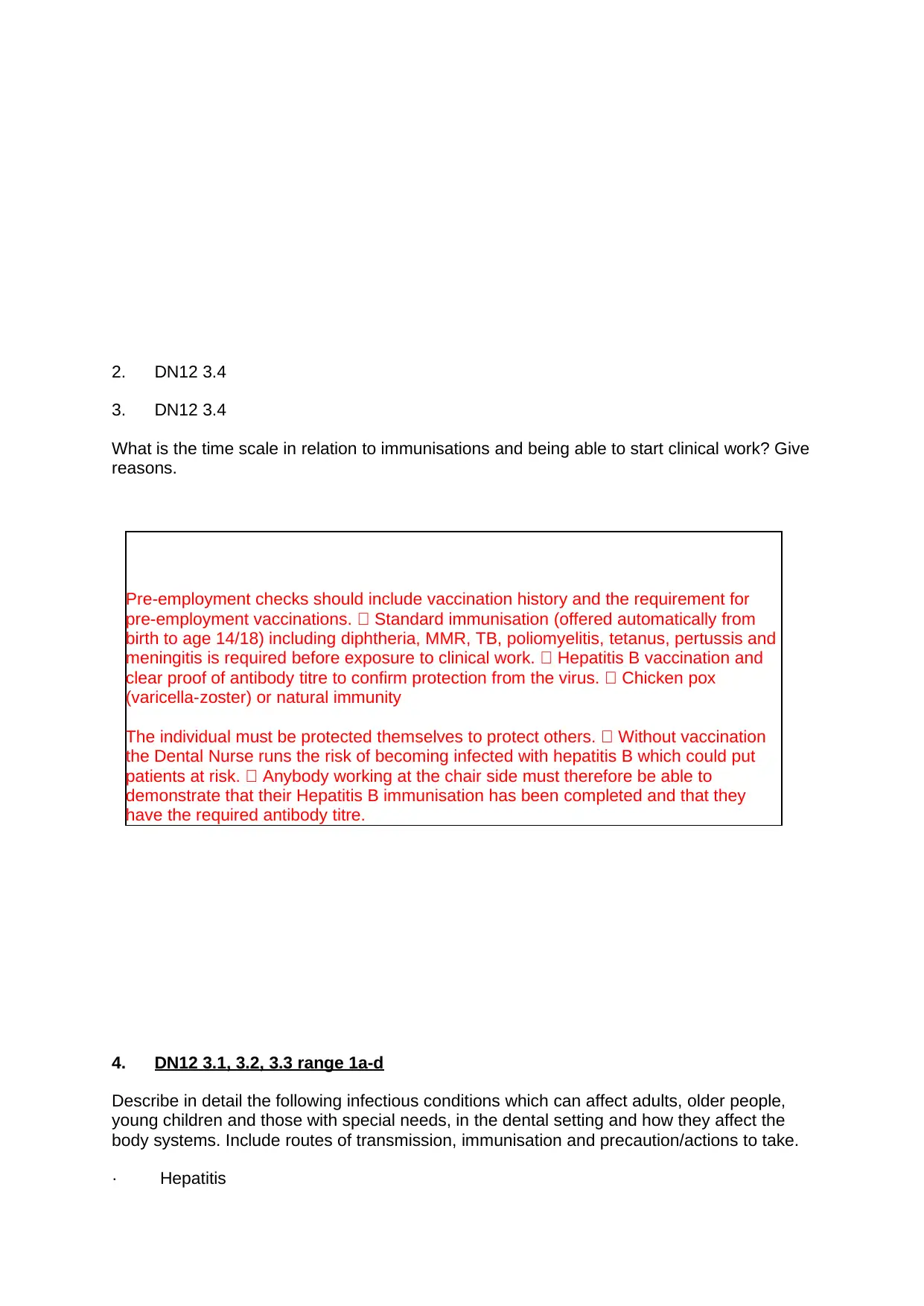
2. DN12 3.4
3. DN12 3.4
What is the time scale in relation to immunisations and being able to start clinical work? Give
reasons.
4. DN12 3.1, 3.2, 3.3 range 1a-d
Describe in detail the following infectious conditions which can affect adults, older people,
young children and those with special needs, in the dental setting and how they affect the
body systems. Include routes of transmission, immunisation and precaution/actions to take.
· Hepatitis
Pre-employment checks should include vaccination history and the requirement for
pre-employment vaccinations. Standard immunisation (offered automatically from
birth to age 14/18) including diphtheria, MMR, TB, poliomyelitis, tetanus, pertussis and
meningitis is required before exposure to clinical work. Hepatitis B vaccination and
clear proof of antibody titre to confirm protection from the virus. Chicken pox
(varicella-zoster) or natural immunity
The individual must be protected themselves to protect others. Without vaccination
the Dental Nurse runs the risk of becoming infected with hepatitis B which could put
patients at risk. Anybody working at the chair side must therefore be able to
demonstrate that their Hepatitis B immunisation has been completed and that they
have the required antibody titre.
3. DN12 3.4
What is the time scale in relation to immunisations and being able to start clinical work? Give
reasons.
4. DN12 3.1, 3.2, 3.3 range 1a-d
Describe in detail the following infectious conditions which can affect adults, older people,
young children and those with special needs, in the dental setting and how they affect the
body systems. Include routes of transmission, immunisation and precaution/actions to take.
· Hepatitis
Pre-employment checks should include vaccination history and the requirement for
pre-employment vaccinations. Standard immunisation (offered automatically from
birth to age 14/18) including diphtheria, MMR, TB, poliomyelitis, tetanus, pertussis and
meningitis is required before exposure to clinical work. Hepatitis B vaccination and
clear proof of antibody titre to confirm protection from the virus. Chicken pox
(varicella-zoster) or natural immunity
The individual must be protected themselves to protect others. Without vaccination
the Dental Nurse runs the risk of becoming infected with hepatitis B which could put
patients at risk. Anybody working at the chair side must therefore be able to
demonstrate that their Hepatitis B immunisation has been completed and that they
have the required antibody titre.
⊘ This is a preview!⊘
Do you want full access?
Subscribe today to unlock all pages.

Trusted by 1+ million students worldwide
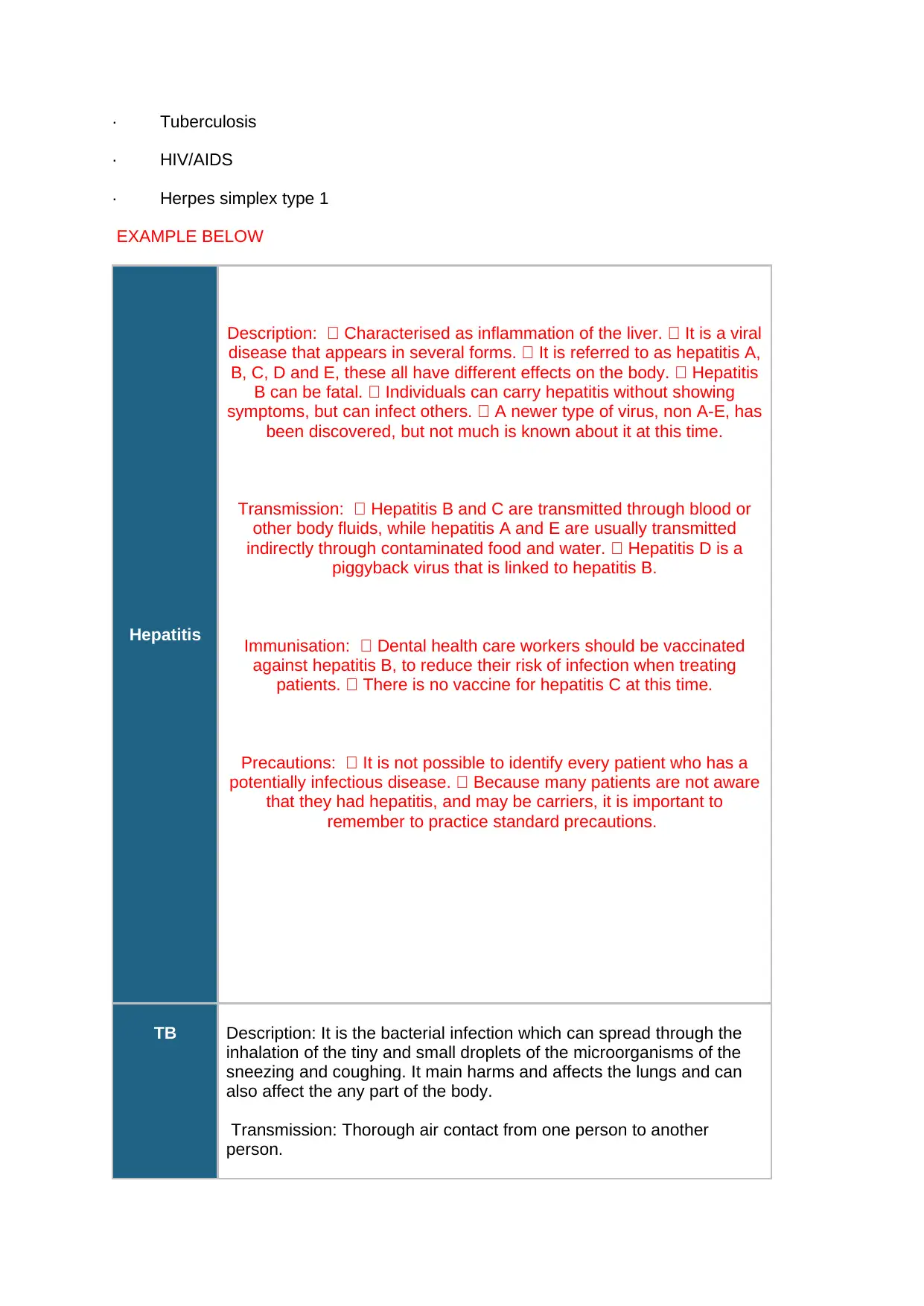
· Tuberculosis
· HIV/AIDS
· Herpes simplex type 1
EXAMPLE BELOW
Hepatitis
Description: Characterised as inflammation of the liver. It is a viral
disease that appears in several forms. It is referred to as hepatitis A,
B, C, D and E, these all have different effects on the body. Hepatitis
B can be fatal. Individuals can carry hepatitis without showing
symptoms, but can infect others. A newer type of virus, non A-E, has
been discovered, but not much is known about it at this time.
Transmission: Hepatitis B and C are transmitted through blood or
other body fluids, while hepatitis A and E are usually transmitted
indirectly through contaminated food and water. Hepatitis D is a
piggyback virus that is linked to hepatitis B.
Immunisation: Dental health care workers should be vaccinated
against hepatitis B, to reduce their risk of infection when treating
patients. There is no vaccine for hepatitis C at this time.
Precautions: It is not possible to identify every patient who has a
potentially infectious disease. Because many patients are not aware
that they had hepatitis, and may be carriers, it is important to
remember to practice standard precautions.
TB Description: It is the bacterial infection which can spread through the
inhalation of the tiny and small droplets of the microorganisms of the
sneezing and coughing. It main harms and affects the lungs and can
also affect the any part of the body.
Transmission: Thorough air contact from one person to another
person.
· HIV/AIDS
· Herpes simplex type 1
EXAMPLE BELOW
Hepatitis
Description: Characterised as inflammation of the liver. It is a viral
disease that appears in several forms. It is referred to as hepatitis A,
B, C, D and E, these all have different effects on the body. Hepatitis
B can be fatal. Individuals can carry hepatitis without showing
symptoms, but can infect others. A newer type of virus, non A-E, has
been discovered, but not much is known about it at this time.
Transmission: Hepatitis B and C are transmitted through blood or
other body fluids, while hepatitis A and E are usually transmitted
indirectly through contaminated food and water. Hepatitis D is a
piggyback virus that is linked to hepatitis B.
Immunisation: Dental health care workers should be vaccinated
against hepatitis B, to reduce their risk of infection when treating
patients. There is no vaccine for hepatitis C at this time.
Precautions: It is not possible to identify every patient who has a
potentially infectious disease. Because many patients are not aware
that they had hepatitis, and may be carriers, it is important to
remember to practice standard precautions.
TB Description: It is the bacterial infection which can spread through the
inhalation of the tiny and small droplets of the microorganisms of the
sneezing and coughing. It main harms and affects the lungs and can
also affect the any part of the body.
Transmission: Thorough air contact from one person to another
person.
Paraphrase This Document
Need a fresh take? Get an instant paraphrase of this document with our AI Paraphraser
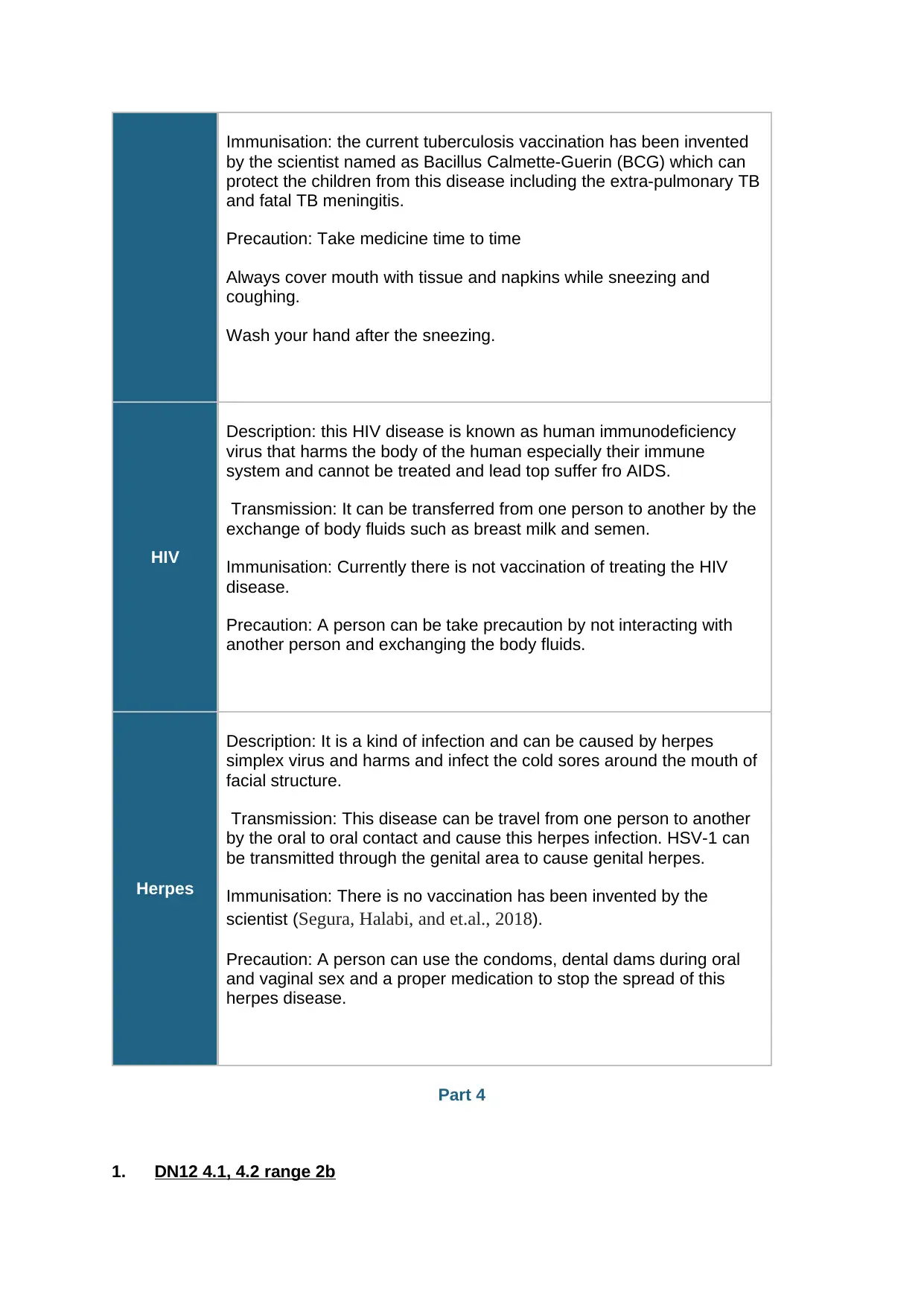
Immunisation: the current tuberculosis vaccination has been invented
by the scientist named as Bacillus Calmette-Guerin (BCG) which can
protect the children from this disease including the extra-pulmonary TB
and fatal TB meningitis.
Precaution: Take medicine time to time
Always cover mouth with tissue and napkins while sneezing and
coughing.
Wash your hand after the sneezing.
HIV
Description: this HIV disease is known as human immunodeficiency
virus that harms the body of the human especially their immune
system and cannot be treated and lead top suffer fro AIDS.
Transmission: It can be transferred from one person to another by the
exchange of body fluids such as breast milk and semen.
Immunisation: Currently there is not vaccination of treating the HIV
disease.
Precaution: A person can be take precaution by not interacting with
another person and exchanging the body fluids.
Herpes
Description: It is a kind of infection and can be caused by herpes
simplex virus and harms and infect the cold sores around the mouth of
facial structure.
Transmission: This disease can be travel from one person to another
by the oral to oral contact and cause this herpes infection. HSV-1 can
be transmitted through the genital area to cause genital herpes.
Immunisation: There is no vaccination has been invented by the
scientist (Segura, Halabi, and et.al., 2018).
Precaution: A person can use the condoms, dental dams during oral
and vaginal sex and a proper medication to stop the spread of this
herpes disease.
Part 4
1. DN12 4.1, 4.2 range 2b
by the scientist named as Bacillus Calmette-Guerin (BCG) which can
protect the children from this disease including the extra-pulmonary TB
and fatal TB meningitis.
Precaution: Take medicine time to time
Always cover mouth with tissue and napkins while sneezing and
coughing.
Wash your hand after the sneezing.
HIV
Description: this HIV disease is known as human immunodeficiency
virus that harms the body of the human especially their immune
system and cannot be treated and lead top suffer fro AIDS.
Transmission: It can be transferred from one person to another by the
exchange of body fluids such as breast milk and semen.
Immunisation: Currently there is not vaccination of treating the HIV
disease.
Precaution: A person can be take precaution by not interacting with
another person and exchanging the body fluids.
Herpes
Description: It is a kind of infection and can be caused by herpes
simplex virus and harms and infect the cold sores around the mouth of
facial structure.
Transmission: This disease can be travel from one person to another
by the oral to oral contact and cause this herpes infection. HSV-1 can
be transmitted through the genital area to cause genital herpes.
Immunisation: There is no vaccination has been invented by the
scientist (Segura, Halabi, and et.al., 2018).
Precaution: A person can use the condoms, dental dams during oral
and vaginal sex and a proper medication to stop the spread of this
herpes disease.
Part 4
1. DN12 4.1, 4.2 range 2b
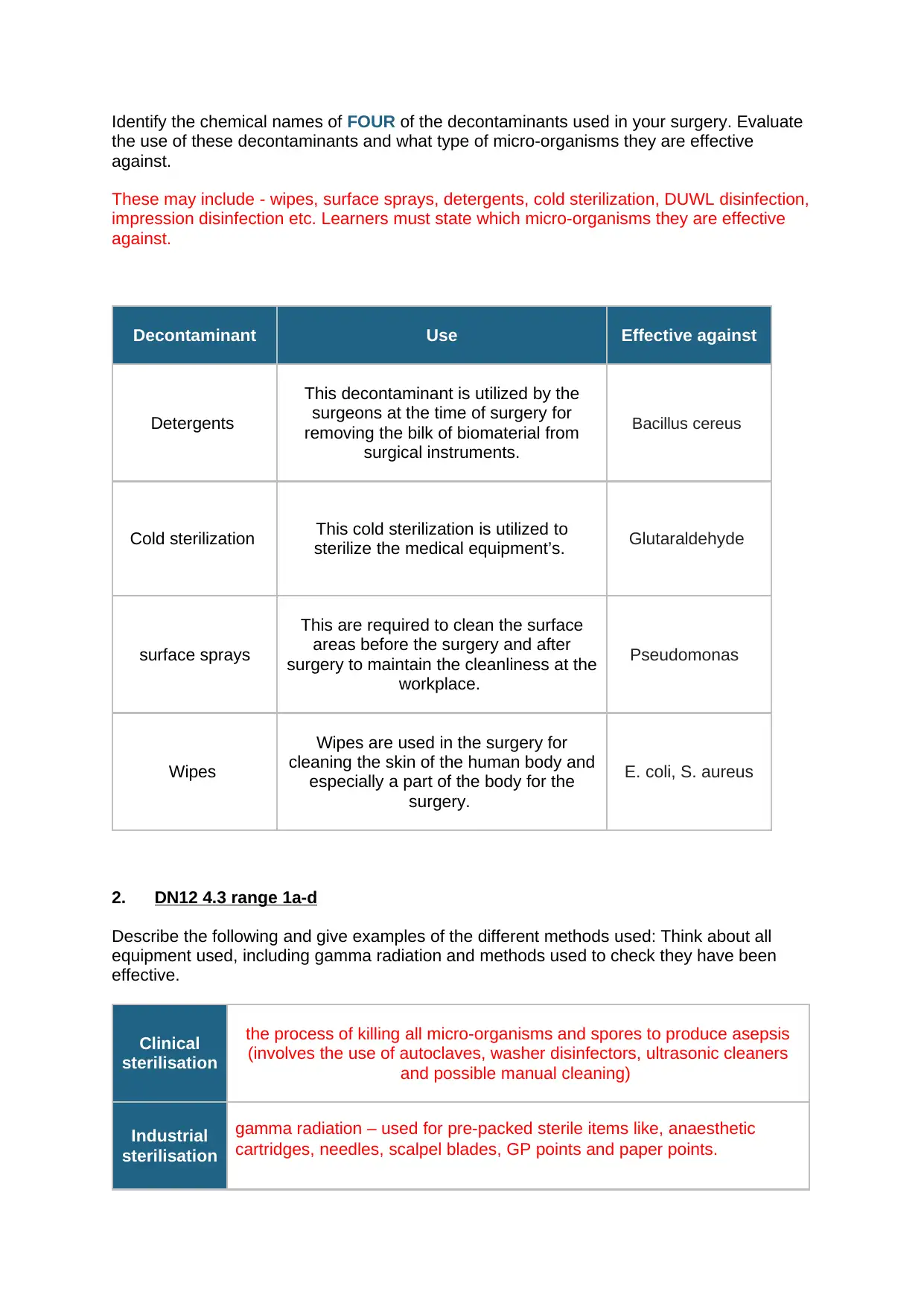
Identify the chemical names of FOUR of the decontaminants used in your surgery. Evaluate
the use of these decontaminants and what type of micro-organisms they are effective
against.
These may include - wipes, surface sprays, detergents, cold sterilization, DUWL disinfection,
impression disinfection etc. Learners must state which micro-organisms they are effective
against.
Decontaminant Use Effective against
Detergents
This decontaminant is utilized by the
surgeons at the time of surgery for
removing the bilk of biomaterial from
surgical instruments.
Bacillus cereus
Cold sterilization This cold sterilization is utilized to
sterilize the medical equipment’s. Glutaraldehyde
surface sprays
This are required to clean the surface
areas before the surgery and after
surgery to maintain the cleanliness at the
workplace.
Pseudomonas
Wipes
Wipes are used in the surgery for
cleaning the skin of the human body and
especially a part of the body for the
surgery.
E. coli, S. aureus
2. DN12 4.3 range 1a-d
Describe the following and give examples of the different methods used: Think about all
equipment used, including gamma radiation and methods used to check they have been
effective.
Clinical
sterilisation
the process of killing all micro-organisms and spores to produce asepsis
(involves the use of autoclaves, washer disinfectors, ultrasonic cleaners
and possible manual cleaning)
Industrial
sterilisation
gamma radiation – used for pre-packed sterile items like, anaesthetic
cartridges, needles, scalpel blades, GP points and paper points.
the use of these decontaminants and what type of micro-organisms they are effective
against.
These may include - wipes, surface sprays, detergents, cold sterilization, DUWL disinfection,
impression disinfection etc. Learners must state which micro-organisms they are effective
against.
Decontaminant Use Effective against
Detergents
This decontaminant is utilized by the
surgeons at the time of surgery for
removing the bilk of biomaterial from
surgical instruments.
Bacillus cereus
Cold sterilization This cold sterilization is utilized to
sterilize the medical equipment’s. Glutaraldehyde
surface sprays
This are required to clean the surface
areas before the surgery and after
surgery to maintain the cleanliness at the
workplace.
Pseudomonas
Wipes
Wipes are used in the surgery for
cleaning the skin of the human body and
especially a part of the body for the
surgery.
E. coli, S. aureus
2. DN12 4.3 range 1a-d
Describe the following and give examples of the different methods used: Think about all
equipment used, including gamma radiation and methods used to check they have been
effective.
Clinical
sterilisation
the process of killing all micro-organisms and spores to produce asepsis
(involves the use of autoclaves, washer disinfectors, ultrasonic cleaners
and possible manual cleaning)
Industrial
sterilisation
gamma radiation – used for pre-packed sterile items like, anaesthetic
cartridges, needles, scalpel blades, GP points and paper points.
⊘ This is a preview!⊘
Do you want full access?
Subscribe today to unlock all pages.

Trusted by 1+ million students worldwide

Disinfectio
n
the killing/destruction of bacteria and fungi, but not spores not some
viruses (this technique involves the use of special chemicals).
3. DN12 LO4 range 2b
What is the difference between asepsis, sterilization and disinfection.
Asepsis: It is an antiseptic which destroys the action of the microbes on the living tissue
and disinfect the objects. There is an absence of the pathogenic organisms in living
tissues.
Sterilization: It is a complete elimination of the microbial visibility which also involve the
bacteria of vegetative forms and spores by physical means (Paixão-Gonçalves, and et.al.,
2019).
Disinfection: It is simply a removal of the spores and viruses founds on non-living things.
n
the killing/destruction of bacteria and fungi, but not spores not some
viruses (this technique involves the use of special chemicals).
3. DN12 LO4 range 2b
What is the difference between asepsis, sterilization and disinfection.
Asepsis: It is an antiseptic which destroys the action of the microbes on the living tissue
and disinfect the objects. There is an absence of the pathogenic organisms in living
tissues.
Sterilization: It is a complete elimination of the microbial visibility which also involve the
bacteria of vegetative forms and spores by physical means (Paixão-Gonçalves, and et.al.,
2019).
Disinfection: It is simply a removal of the spores and viruses founds on non-living things.
Paraphrase This Document
Need a fresh take? Get an instant paraphrase of this document with our AI Paraphraser
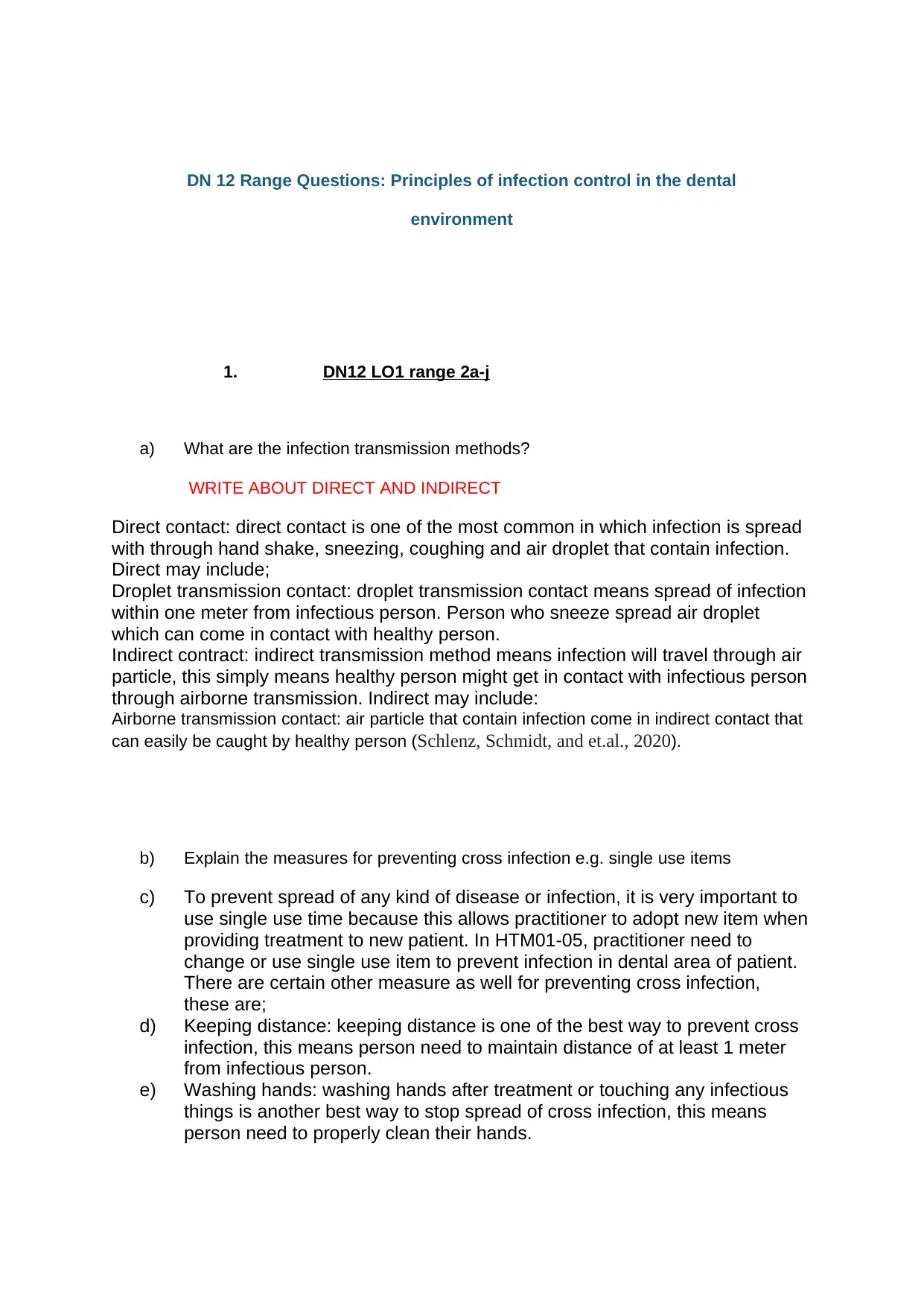
DN 12 Range Questions: Principles of infection control in the dental
environment
1. DN12 LO1 range 2a-j
a) What are the infection transmission methods?
WRITE ABOUT DIRECT AND INDIRECT
Direct contact: direct contact is one of the most common in which infection is spread
with through hand shake, sneezing, coughing and air droplet that contain infection.
Direct may include;
Droplet transmission contact: droplet transmission contact means spread of infection
within one meter from infectious person. Person who sneeze spread air droplet
which can come in contact with healthy person.
Indirect contract: indirect transmission method means infection will travel through air
particle, this simply means healthy person might get in contact with infectious person
through airborne transmission. Indirect may include:
Airborne transmission contact: air particle that contain infection come in indirect contact that
can easily be caught by healthy person (Schlenz, Schmidt, and et.al., 2020).
b) Explain the measures for preventing cross infection e.g. single use items
c) To prevent spread of any kind of disease or infection, it is very important to
use single use time because this allows practitioner to adopt new item when
providing treatment to new patient. In HTM01-05, practitioner need to
change or use single use item to prevent infection in dental area of patient.
There are certain other measure as well for preventing cross infection,
these are;
d) Keeping distance: keeping distance is one of the best way to prevent cross
infection, this means person need to maintain distance of at least 1 meter
from infectious person.
e) Washing hands: washing hands after treatment or touching any infectious
things is another best way to stop spread of cross infection, this means
person need to properly clean their hands.
environment
1. DN12 LO1 range 2a-j
a) What are the infection transmission methods?
WRITE ABOUT DIRECT AND INDIRECT
Direct contact: direct contact is one of the most common in which infection is spread
with through hand shake, sneezing, coughing and air droplet that contain infection.
Direct may include;
Droplet transmission contact: droplet transmission contact means spread of infection
within one meter from infectious person. Person who sneeze spread air droplet
which can come in contact with healthy person.
Indirect contract: indirect transmission method means infection will travel through air
particle, this simply means healthy person might get in contact with infectious person
through airborne transmission. Indirect may include:
Airborne transmission contact: air particle that contain infection come in indirect contact that
can easily be caught by healthy person (Schlenz, Schmidt, and et.al., 2020).
b) Explain the measures for preventing cross infection e.g. single use items
c) To prevent spread of any kind of disease or infection, it is very important to
use single use time because this allows practitioner to adopt new item when
providing treatment to new patient. In HTM01-05, practitioner need to
change or use single use item to prevent infection in dental area of patient.
There are certain other measure as well for preventing cross infection,
these are;
d) Keeping distance: keeping distance is one of the best way to prevent cross
infection, this means person need to maintain distance of at least 1 meter
from infectious person.
e) Washing hands: washing hands after treatment or touching any infectious
things is another best way to stop spread of cross infection, this means
person need to properly clean their hands.
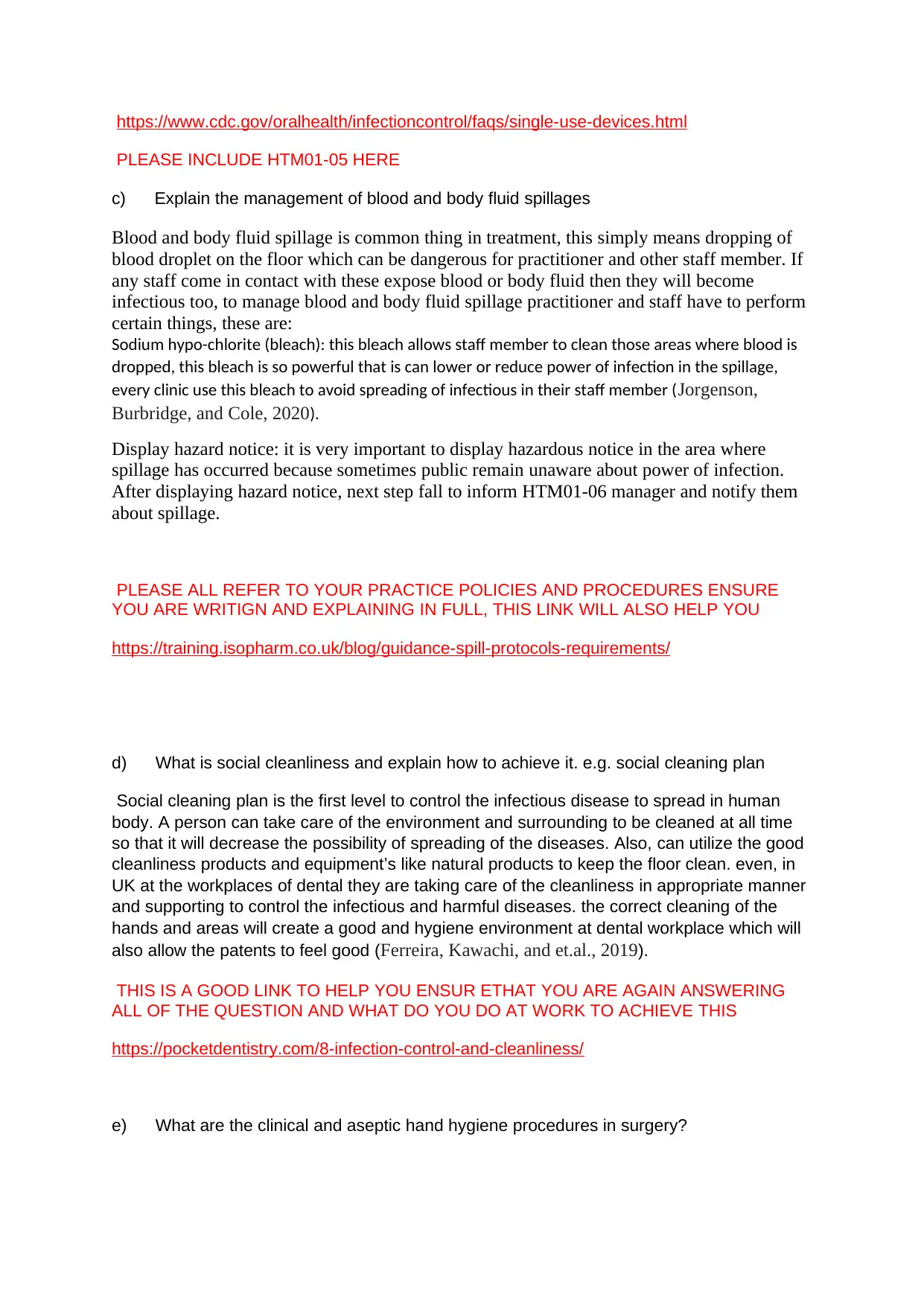
https://www.cdc.gov/oralhealth/infectioncontrol/faqs/single-use-devices.html
PLEASE INCLUDE HTM01-05 HERE
c) Explain the management of blood and body fluid spillages
Blood and body fluid spillage is common thing in treatment, this simply means dropping of
blood droplet on the floor which can be dangerous for practitioner and other staff member. If
any staff come in contact with these expose blood or body fluid then they will become
infectious too, to manage blood and body fluid spillage practitioner and staff have to perform
certain things, these are:
Sodium hypo-chlorite (bleach): this bleach allows staff member to clean those areas where blood is
dropped, this bleach is so powerful that is can lower or reduce power of infection in the spillage,
every clinic use this bleach to avoid spreading of infectious in their staff member (Jorgenson,
Burbridge, and Cole, 2020).
Display hazard notice: it is very important to display hazardous notice in the area where
spillage has occurred because sometimes public remain unaware about power of infection.
After displaying hazard notice, next step fall to inform HTM01-06 manager and notify them
about spillage.
PLEASE ALL REFER TO YOUR PRACTICE POLICIES AND PROCEDURES ENSURE
YOU ARE WRITIGN AND EXPLAINING IN FULL, THIS LINK WILL ALSO HELP YOU
https://training.isopharm.co.uk/blog/guidance-spill-protocols-requirements/
d) What is social cleanliness and explain how to achieve it. e.g. social cleaning plan
Social cleaning plan is the first level to control the infectious disease to spread in human
body. A person can take care of the environment and surrounding to be cleaned at all time
so that it will decrease the possibility of spreading of the diseases. Also, can utilize the good
cleanliness products and equipment’s like natural products to keep the floor clean. even, in
UK at the workplaces of dental they are taking care of the cleanliness in appropriate manner
and supporting to control the infectious and harmful diseases. the correct cleaning of the
hands and areas will create a good and hygiene environment at dental workplace which will
also allow the patents to feel good (Ferreira, Kawachi, and et.al., 2019).
THIS IS A GOOD LINK TO HELP YOU ENSUR ETHAT YOU ARE AGAIN ANSWERING
ALL OF THE QUESTION AND WHAT DO YOU DO AT WORK TO ACHIEVE THIS
https://pocketdentistry.com/8-infection-control-and-cleanliness/
e) What are the clinical and aseptic hand hygiene procedures in surgery?
PLEASE INCLUDE HTM01-05 HERE
c) Explain the management of blood and body fluid spillages
Blood and body fluid spillage is common thing in treatment, this simply means dropping of
blood droplet on the floor which can be dangerous for practitioner and other staff member. If
any staff come in contact with these expose blood or body fluid then they will become
infectious too, to manage blood and body fluid spillage practitioner and staff have to perform
certain things, these are:
Sodium hypo-chlorite (bleach): this bleach allows staff member to clean those areas where blood is
dropped, this bleach is so powerful that is can lower or reduce power of infection in the spillage,
every clinic use this bleach to avoid spreading of infectious in their staff member (Jorgenson,
Burbridge, and Cole, 2020).
Display hazard notice: it is very important to display hazardous notice in the area where
spillage has occurred because sometimes public remain unaware about power of infection.
After displaying hazard notice, next step fall to inform HTM01-06 manager and notify them
about spillage.
PLEASE ALL REFER TO YOUR PRACTICE POLICIES AND PROCEDURES ENSURE
YOU ARE WRITIGN AND EXPLAINING IN FULL, THIS LINK WILL ALSO HELP YOU
https://training.isopharm.co.uk/blog/guidance-spill-protocols-requirements/
d) What is social cleanliness and explain how to achieve it. e.g. social cleaning plan
Social cleaning plan is the first level to control the infectious disease to spread in human
body. A person can take care of the environment and surrounding to be cleaned at all time
so that it will decrease the possibility of spreading of the diseases. Also, can utilize the good
cleanliness products and equipment’s like natural products to keep the floor clean. even, in
UK at the workplaces of dental they are taking care of the cleanliness in appropriate manner
and supporting to control the infectious and harmful diseases. the correct cleaning of the
hands and areas will create a good and hygiene environment at dental workplace which will
also allow the patents to feel good (Ferreira, Kawachi, and et.al., 2019).
THIS IS A GOOD LINK TO HELP YOU ENSUR ETHAT YOU ARE AGAIN ANSWERING
ALL OF THE QUESTION AND WHAT DO YOU DO AT WORK TO ACHIEVE THIS
https://pocketdentistry.com/8-infection-control-and-cleanliness/
e) What are the clinical and aseptic hand hygiene procedures in surgery?
⊘ This is a preview!⊘
Do you want full access?
Subscribe today to unlock all pages.

Trusted by 1+ million students worldwide
1 out of 16
Related Documents
Your All-in-One AI-Powered Toolkit for Academic Success.
+13062052269
info@desklib.com
Available 24*7 on WhatsApp / Email
![[object Object]](/_next/static/media/star-bottom.7253800d.svg)
Unlock your academic potential
Copyright © 2020–2025 A2Z Services. All Rights Reserved. Developed and managed by ZUCOL.





